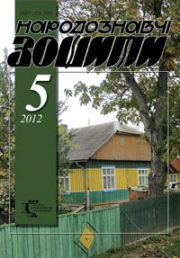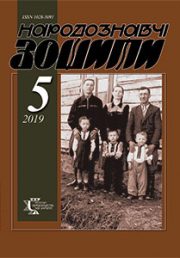The Ethnology Notebooks. 2017, 4 (136), 875–895
UDK 75.035.5+712.3/.7+[630+639]
DOI https://doi.org/10.15407/nz2017.04.875
HISTORICAL AND CULTURAL ESSAY OF SKOLE REGION OF BOIKIVSHCHYNA
Taras Viktoriia Yaroslavivna, Ph.D in Architecture,
senior research fellow, doctoral student
at the Institute of Ethnology
of the National Academy of Sciences of Ukraine
Svobody Avenue, 15, Lviv, 79000, Ukraine
Contacts: Tel. (032) 0970157; e-mail: ina@mail.lviv.ua
Abstract. The process of appearance and development of boiko`s town Skole is analyzed. The characteristics of every town`s owner individual features is given below. It is defined the level of theirs influence on the planning structure, defensive, trading, handcrafting, administrative, representative, religious, cultural, educational, representative, cultural, educational, serving, recreational and touristic functions. Processes of colonization at Skolivshchyna are considered. Aspects of boiko`s town Skole and its neighborhood development due to conditions of market economy formation at the second half of XIX — the beginning of XX century are explored.
Keywords: Boiikivshchyna, Skole, architecture, self-government, settlement, culture, education, ethnology.
Received 11.07.2017
REFERENCES
Istoriia mist i sil Ukrains’koi RSR: v 26 t. (1968). Hol. red. kol. P. T. Tron’ko, M. P. Bazhan, I. K. Bilodid, M. K. Bilohurov ta in. Kyiv: Ukr. rad. entsyklopediia AN URSR. (L’vivs’ka oblast’) [in Ukrainian].
Literaturnyj Sbornik izdavaemyj Galicko-russkoju Maticeju. (1870). S. 79 [in Russian].
Lozyns’kyj, R. (2001). Chomu Halychyna vidstaie? abo Yak dovho my sche budemo vidstavaty? Postup. L’viv. № 137 (795) [in Ukrainian].
Nahorna, Oksana. (1996). Pidzemni taiemnytsi Karpat. Kraieznavstvo i turystyka. Vyp. 12 [in Ukrainian].
Slovo pro hr. Al’freda Pototskoho (1889). Dilo. L’viv. 10 (22). Maia [in Russian].
Taras, V. (2015). Vplyv mistobudivnykh chynnykiv periodu baroko na rozplanuvannia rezydentsijnykh sadovo-parkovykh zakladen’ Halychyny.Narodoznavchi zoshyty. L’viv: Instytut narodoznavstva. № 1 (121) [in Ukrainian].
Tvory Kyr Josyfa Verkhovnoho Arkhyiepyskopa i Kardynala (1971). Zibraly prof. doktor Ivan Khoma, doktor Yurij Fedoriv. Rym: Ukr. katolyts’kyj un-t im. sv. Klymentiia Papy. T. V [in Ukrainian].
Heinrich Eduard, Gintl. (1873). Wykaz udziału Galicyi i wielkiego księztwa Krakowskiego napowszechnej wystawie 1873 w Wiedniu.Wiedeń: nakł. Reprezentacyi wiedeńskiej galicyjskich komisyj wystawowych [in Polish].
Kriegsarchivdes Österreichischen Staatsarchivs in Wien. Josephinische Landesaufnahme, 17631787. B IXa 390. B. 197 [in German].
Leo Baeck Institute. Center for Jewish History NewYork, N.Y. Guideto the Nussbaum Family, Friedbergin Hessen, Collection, 1849–1937. AR 2400. Processed by Timothy Ryan Mendenhall. Documents and correspondence 1849–1937.
Papée, Fryderyk. (1891). Skole i Tucholszczyzna: monografia historyczna. Lwów: Gubrynowicz i Schmidt (Lwów: W. Łoziński) [in Polish].
Ortis-Repertoriumdes Königreich Galizienund Lodomerien auf Grundlageder Volkzählung v. 1869 bearbeiten v. d. k. k. statist. Central commission. (1874).Wien; Special-Orts-Repertoriumvon Galizien. Wien [in German].
Słownik geograficzny Królestwa Polskiego i innych krajów słowiańskich. (1880–1914).. Warszawa: nakł. Filipa Sulimierskiego i Władysława Walewskiego. T. X [in Polish].
Zełeski, P.(2007). Skolskie rykowiska. Łowiec Polski. № 9. S. 64–67[in Polish]
Retrieved from: http://wikivisually.com/wiki/Skolye_(Hasidic_dynasty) [in Polish].
Retrieved from: https://www.geni.com/projects/Jewish Families of Skole Poland Galicia/15777.
Retrieved from: https://www.geni.com/people/Zadig Zadik Groedel/ 6000000015884655160.
Retrieved from: https://www.geni.com/people/FannyGroedel/60000 00015884449420.
Retrieved from: https://www.geni.com/people/BerthaHilb/60000 00015884374588.
Retrieved from: https://www.geni.com/people/Margare the Groedelvon GyulafalvaundBogd%C3%A1n/60000000 23261124889.
Retrieved from: https://www.geni.com/people/GiselaGroedelvonGyulafalvaundBogd%C3%A1n/600000001 0012011361.
Retrieved from: https://www.geni.com/people/MelanieGroedelvonGyulafalvaundBogd%C3%A1n/60000000158 84321668.
Retrieved from: https://www.geni.com/people/LudwigGroedelvonGyulafalvaundBogd%C3%A1n/60000000 15884553880.
Retrieved from: https://www.geni.com/people/ArthurGroedelvonGyulafalvaundBogd%C3%A1n/60000000158 84198844.
Retrieved from: https://www.geni.com/people/OttoGroedelvonGyulafalvaundBogd%C3%A1n/60000000158 84659699.
Retrieved from: https://www.geni.com/people/AlbertGroedelvonGyulafalvaundBogd%C3%A1n/60000000158 84589690.
Retrieved from: https://www.geni.com/people/RichardGroedelvonGyulafalvaundBogd%C3%A1n/60000000158 84599893.
Retrieved from: http://www.centrum.jaroslawrokicki.pl/tablice.php?ulice=g.
Retrieved from: https://www.geni.com/people/ PaulaL%C3%B3 nyaydeNagyL%C3%B3nyaundV%C3% A1s%C3%A1rosNam%C3%A9ny/ 60000000 15884685230.
Retrieved from: https://www.geni.com/people/StephanievonKoenigswarter/6000000013145225580.
Retrieved from: https://www.geni.com/people/IrenSv%C3%A1b/ 6000000015884594709.
Retrieved from: www.arrowgauge.hu, www.directbooking.ro.
Retrieved from: http://www.museumoffamilyhistory.com/psegroedel.htm.
Retrieved from: http://hhtandn.org/hartlepoolshipsandshipping/ shipbuilding/200/Gray’s%20Shipyard/ship/595/melaniegroedel.
Jaroslav Shimov. «Batja»: kakcheshskiebotinkivsjuplanetuoboshliURL: http://www.radio.cz/ru/rubrika/progulki/batyakakcheshskie
botinki vsyu planetu oboshli [in Russian].
Retrieved from: http://forowicz.pl/wspomnienia.htm.
Retrieved from: http://www.panadea.com/uk/putivnik/yevropa/ugorshina/ budapeshtiiogookolici/budahills/budapesht/fotohalereya/gal037.
Retrieved from: https://www.geni.com/people/HermannGroedelvonGyulafalvaundBogd%C3%A1n/ 60000000 15884196825.
Retrieved from: https://www.geni.com/people/ BaronBern%C3%A1tGroedelvonGyulafalvaundBogd%C3%A1n/ 6000000023261120940.
Retrieved from: http://www.centrum.jaroslawrokicki.pl/tablice.php?ulice=g.






